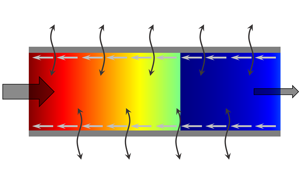Article contents
Analysis of the choking condition of one-dimensional diabatic flows with wall friction
Published online by Cambridge University Press: 12 October 2023
Abstract

The choking condition of a one-dimensional steady-state diabatic flow, with wall friction, of a perfect gas through a constant cross-section pipe has been analysed by applying a recent analytical solution. Such a choking condition can be achieved for an initially subsonic flow and a supersonic one, even when the heat flux goes from the fluid to the wall. Entropy–enthalpy diagrams have been analysed, and a universal choking condition for compressible diabatic flows with wall friction has been determined. The analytical solution of a supersonic flow, in which a normal shock occurs, has been obtained for a diabatic flow with wall friction and compared with the results of a numerical model.
JFM classification
- Type
- JFM Papers
- Information
- Copyright
- © The Author(s), 2023. Published by Cambridge University Press
References
- 1
- Cited by



